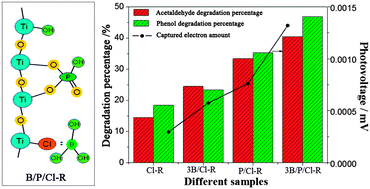Enhanced photocatalytic activity of Cl-residual rutile TiO2 nanorods after targeted co-modification with phosphoric and boric acids†
Abstract
The promotion of O2 adsorption on semiconductor surfaces for effectively capturing photogenerated electrons in the photocatalytic degradation of pollutants is highly desired. In this study, the targeted co-modification of residual chlorine rutile TiO2 nanorods with phosphoric and boric acids has been accomplished for the first time by simple wet chemical processes. The key to targeted co-modification is to connect –P–OH and –B–OH to the Cl-residual TiO2 surfaces by –Ti–OH and –Ti–Cl, respectively, consequently forming –Ti–O–P–OH and –Ti–Cl:B–OH ends. By means of the atmosphere-controlled surface photovoltage spectroscopy, the degrees for capturing photogenerated electrons by the adsorbed O2 as receptors on the resulting TiO2 nanorods are quantitatively analyzed. It is confirmed that the targeted co-modification could greatly promote the capture of the photogenerated electrons compared to the phosphate and borate modification alone. This is attributed to increased amounts of adsorbed O2 based on electrochemical O2 reduction and O2 temperature-programmed desorption measurements, further leading to the enhanced separation of photogenerated charges, characterized by an increase in the amount of produced hydroxyl radicals. This is responsible for the obviously enhanced photocatalytic activity of TiO2 nanorods towards the degradation of colorless gas-phase acetaldehyde and liquid-phase phenol. This work would provide us a feasible route for the co-modification with inorganic acids to synthesize efficient nanosized TiO2-based photocatalysts.


 Please wait while we load your content...
Please wait while we load your content...